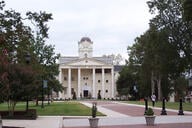You have /5 articles left.
Sign up for a free account or log in.

Getty Images
Wealthy universities’ endowments are once again in the crosshairs on Capitol Hill.
Amid double-digit investment returns and growing public anxiety about student debt and the price of college, members of Congress are reviving their scrutiny of the nation’s richest colleges, an issue that largely was put on hold after the financial crisis in 2008.
Earlier this week two congressional committees sent letters to several dozen colleges and universities, seeking a wide range of information about how they manage their endowments and spend endowment funds.
Senator Orrin Hatch, chairman of the Senate Finance Committee, Representative Kevin Brady, chairman of the House Ways and Means Committee, and Representative Peter Roskam, chairman of the House Ways and Means Subcommittee on Oversight, wrote to 56 private colleges with endowments larger than $1 billion.
“Despite these large and growing endowments, many colleges and universities have raised tuition far in excess of inflation,” wrote the three lawmakers, all Republicans. The committees, they said, are looking into “how colleges and universities are using endowment assets to fulfill their charitable and educational purposes.” They instructed colleges to respond by April 1.
The letters follow a congressional hearing last fall in which House Republicans criticized large university endowments and executive compensation in higher education.
Representative Tom Reed of New York, a Republican, plans to introduce legislation that would require colleges with endowments of more than $1 billion to pay out 25 percent of their annual earnings to reduce the cost of attendance for “working families,” those earning between 100 and 600 percent of the poverty line, according to a fact sheet provided by his office.
If colleges were to cover the entire cost for those families with endowment earnings left over, they would then have to direct the money to reducing the cost of attendance for low-income families, presumably those earning less than 100 percent of the poverty line. Colleges that do not comply would face penalties, including the possible loss of tax-exempt status.
“We care about ensuring fairness in higher education and allowing every child to succeed without holding them back because of cost,” Reed said in a statement. “It’s only right that we begin looking for solutions to get the cost of higher education under control, and this is a step in the right direction in that process.”
With the exception of this past year – in which the average endowment grew by just 2.4 percent -- college and university endowments have seen double-digit returns in recent years.
Catharine Bond Hill, president of Vassar College and an economist who studies higher education, says the latest round of attention to university endowments may also partly reflect growing concern about income inequality.
“The richer schools are getting richer and the poorer schools, in some cases, are getting poorer,” she said.
Endowment wealth is heavily concentrated at the richest institutions. Nearly 11 percent of colleges hold almost three-quarters of all endowment wealth among the 832 institutions that participate in the annual endowment study by the National Association of College and University Business Officers, according to a recent analysis by the Congressional Research Service.
Since the financial crisis, the nation’s 40 richest universities have also seen increases in their endowment assets that are more than double those of universities with fewer resources, according to Moody’s.
As congressional lawmakers channel the public frustration over those increases in wealth and rising sticker prices on tuition at those institutions, they’re returning to proposals that would force -- or use tax benefits to prod -- universities to spend more of their endowment funds.
The Congressional Research Service analysis also floats the previously discussed ideas of taxing endowments or endowment earnings or curbing the tax benefits associated with making donations to wealthy endowments. Donations to rich colleges, in particular, have received much attention recently in the wake of a series of large gifts, such as a $400 million contribution to Harvard's engineering college. That gift sparked especially strong backlash, with some columns urging people to stop giving to such wealthy institutions.
But Hill, like many other higher education experts, argues that such proposals miss the mark. Because many wealthy institutions have already reduced the net price for low- and middle-income families, she said, further required spending on financial aid may end up benefiting wealthy families the most.
“It’s not clear that’s going to improve issues of access at these schools,” she said. “I would much rather see these schools increase their enrollment of low-income students.”
Ronald Ehrenberg, director of the Cornell University Higher Education Research Institute, said many of the proposals that lawmakers are considering don’t reflect a full understanding of how universities are financed.
On the one hand, Ehrenberg said, the focus of the congressional inquiry on only private colleges does reflect a more nuanced understanding. When lawmakers last probed the issue in 2007, they asked 136 institutions -- public and private -- for information about their endowment spending.
“I was very happy that they excluded public institutions, because I think they finally realized that the major factor at most public institutions is the failure of state support to keep up with costs and the growth of students,” he said.
At the same, though, he said some of the congressional attention reflects “this myth that if they were to require higher payout rates that this would lead to massive infusions of financial aid, and at most places that would not be the case.”
“Higher required spending rates lead to slower growth rates for endowments in the long run,” he said. “That’s what the universities are concerned about.”
As lawmakers return to considering changes to how the federal tax code treats university endowments, they have a sizable amount of work on which to draw.
In 2014, then Representative Dave Camp, a Republican who chaired the Ways and Means Committee, included a 1 percent tax on the investment earnings of college and university endowments as part of his tax code overhaul. It would have applied to colleges with endowments larger than $100,000 per student.
And previously, Senator Chuck Grassley, a Republican, in 2007 and 2008 prominently criticized wealthy university endowments, held hearings and sent letters to college and universities. Grassley floated the idea of requiring universities to spend a certain amount of their endowments each year. Although his plans were dropped, the scrutiny is widely credited with spurring more generous, no-loan financial aid packages for low- and middle-income students at the wealthiest institutions.
Dean Zerbe was senior counsel to the Senate Finance Committee when Grassley (and the panel’s top Democrat at the time, Senator Max Baucus) scrutinized university endowment spending.
That effort “really gave the tax policy community on the Hill an understanding of these issues, and I think there’s a real appetite to take a hard look at this and take it to the next level,” he said.
“It’s very hard to justify the current policy,” said Zerbe, who is now a partner at Zerbe Fingeret Frank & Jadav in Texas. “We’re sending billions of dollars in tax benefits to the wealthy colleges” without incentives to hold down tuition.
“It’s an area where you could find an enormous amount of common ground,” he said. “There’s a lot of rhetoric about the 1 percent in the election cycle. Well it is the 1 percent of colleges getting these benefits; it’s not any community college getting a tax break for endowments.”
But it’s not yet clear if Democrats, who have been pushing student loan debt as an election-year issue, will join in on efforts to go after university endowment spending. Some House Democrats said at a hearing last year that they thought the focus on endowments was a side issue from more pressing concerns on student loan debt.
Senator Patty Murray, the top Democrat on the Senate education committee, said at a press conference last month that Reed’s legislation, which would apply only to colleges with endowments above $1 billion, “doesn’t affect very many students,” adding that “we’re trying to have a broad agenda that really impacts a lot of families.”




